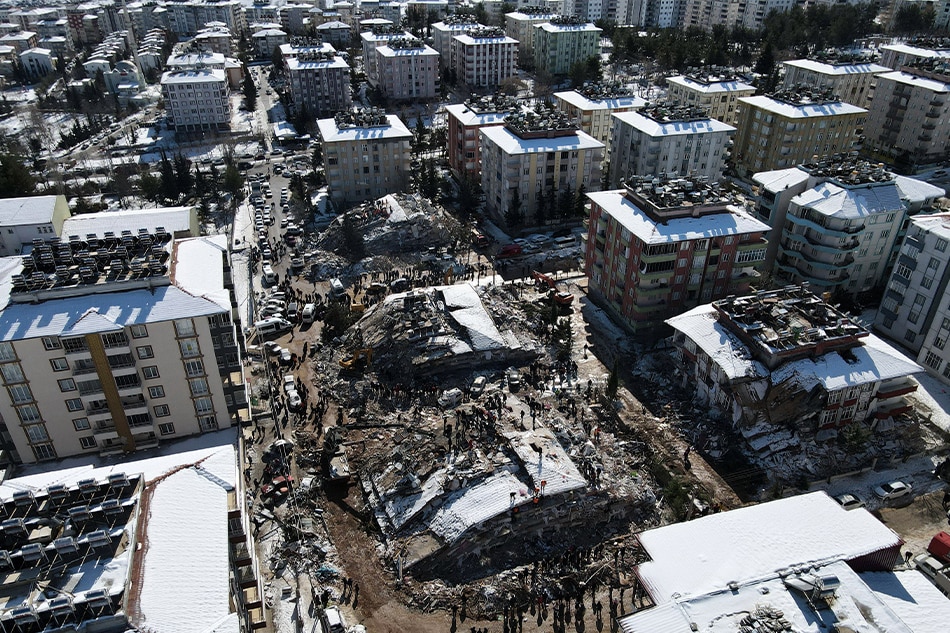Prescription before 'The Big One': Fix Building Code, remove homes on earthquake faults
ADVERTISEMENT

Welcome, Kapamilya! We use cookies to improve your browsing experience. Continuing to use this site means you agree to our use of cookies. Tell me more!
Prescription before 'The Big One': Fix Building Code, remove homes on earthquake faults
David Dizon,
ABS-CBN News
Published Feb 16, 2023 11:36 AM PHT
|
Updated Feb 17, 2023 08:21 AM PHT
MANILA — Renowned architect and urban planner Felino "Jun" Palafox Jr. has a prescription in these disaster-ridden times: update the National Building Code and demolish houses built on earthquake faults before the Big One hits.
MANILA — Renowned architect and urban planner Felino "Jun" Palafox Jr. has a prescription in these disaster-ridden times: update the National Building Code and demolish houses built on earthquake faults before the Big One hits.
A study conducted by the Japan International Cooperation Agency (JICA), in cooperation with the Philippine Institute of Volcanology and Seismology and the Metropolitan Manila Development Authority, earlier said that a 7.2 magnitude earthquake in Metro Manila could leave more than 30,000 people dead and approximately 100,000 others injured.
A study conducted by the Japan International Cooperation Agency (JICA), in cooperation with the Philippine Institute of Volcanology and Seismology and the Metropolitan Manila Development Authority, earlier said that a 7.2 magnitude earthquake in Metro Manila could leave more than 30,000 people dead and approximately 100,000 others injured.
Palafox said the Metropolitan Manila Earthquake Impact Reduction Study (MMEIRS) needs renewed focus following the 7.8-magnitude tremor that killed over 40,000 people in Turkey and Syria.
Palafox said the Metropolitan Manila Earthquake Impact Reduction Study (MMEIRS) needs renewed focus following the 7.8-magnitude tremor that killed over 40,000 people in Turkey and Syria.
One problem, he said, is that under the Philippines' antiquated building code, structures only need to be 1 meter apart even if it goes as high as 100 stories.
One problem, he said, is that under the Philippines' antiquated building code, structures only need to be 1 meter apart even if it goes as high as 100 stories.
ADVERTISEMENT
This has surprised the Council on Tall Buildings and Urban Habitat, an international body in the field of tall buildings and sustainable urban design.
This has surprised the Council on Tall Buildings and Urban Habitat, an international body in the field of tall buildings and sustainable urban design.
"Kasi kahit magpatayo ka ng very tall building, 100 stories, sa building code e 1 meter apart lang po...Kaya ang mga developers mina-maximize nila," Palafox said in a TeleRadyo interview.
"Kasi kahit magpatayo ka ng very tall building, 100 stories, sa building code e 1 meter apart lang po...Kaya ang mga developers mina-maximize nila," Palafox said in a TeleRadyo interview.
(Even if you build a very tall building, 100 stories, a 1-meter gap would do under the building code. Developers maximize this.)
(Even if you build a very tall building, 100 stories, a 1-meter gap would do under the building code. Developers maximize this.)
The architect noted that very tall buildings "sway by design...like pine trees" to withstand the impact of earthquakes.
The architect noted that very tall buildings "sway by design...like pine trees" to withstand the impact of earthquakes.
He noted that under the JICA study, a massive quake would more likely destroy low-rise buildings while only 2 percent of tall buildings would collapse.
He noted that under the JICA study, a massive quake would more likely destroy low-rise buildings while only 2 percent of tall buildings would collapse.
ADVERTISEMENT
Palafox said one solution he implements in his own firm is to instruct structural engineers "to design [the buildings] 10 percent over and above the building code, structural code and other engineering codes."
Palafox said one solution he implements in his own firm is to instruct structural engineers "to design [the buildings] 10 percent over and above the building code, structural code and other engineering codes."
He cited as an example the first 5 towers of Rockwell, which stand 30 meters apart compared to only 1 meter under the building code.
He cited as an example the first 5 towers of Rockwell, which stand 30 meters apart compared to only 1 meter under the building code.
One Palafox-designed building, the Bed and Brew Hostel in Siargao, also withstood the impact of Super Typhoon Odette, despite causing P20 billion worth of damage on the island, he said.
One Palafox-designed building, the Bed and Brew Hostel in Siargao, also withstood the impact of Super Typhoon Odette, despite causing P20 billion worth of damage on the island, he said.
Palafox said that under the JICA study, a massive quake would be more dangerous to informal settlers whose houses are built with light materials. "Mas maraming mapinsala [sa mga] informal settlers kasi dikit-dikit ang mga bahay nila," he said.
Palafox said that under the JICA study, a massive quake would be more dangerous to informal settlers whose houses are built with light materials. "Mas maraming mapinsala [sa mga] informal settlers kasi dikit-dikit ang mga bahay nila," he said.
(Informal settlers would suffer more damage because their houses are crowded together.)
(Informal settlers would suffer more damage because their houses are crowded together.)
ADVERTISEMENT
Another danger that needs to be addressed, he said, is the building of subdivisions on top of faultlines. His solution? "Homes built on top of faultlines should be demolished and set back 5 meters from the faultline," he said.
Another danger that needs to be addressed, he said, is the building of subdivisions on top of faultlines. His solution? "Homes built on top of faultlines should be demolished and set back 5 meters from the faultline," he said.
He also cited the importance of open areas in the city, which function as the "lungs" of a city and serve as evacuation areas during an earthquake.
He also cited the importance of open areas in the city, which function as the "lungs" of a city and serve as evacuation areas during an earthquake.
He also encouraged design professionals, contractors, architects, engineers and project managers to expose corruption, which leads to poor quality of structures that collapse during earthquakes. He cited as an example one contractor who allegedly had to give 28 percent in kickbacks so he could be paid.
He also encouraged design professionals, contractors, architects, engineers and project managers to expose corruption, which leads to poor quality of structures that collapse during earthquakes. He cited as an example one contractor who allegedly had to give 28 percent in kickbacks so he could be paid.
At least 12 people including contractors were detained by Turkish police after 6,000 buildings collapsed during the Feb. 6 earthquake.
At least 12 people including contractors were detained by Turkish police after 6,000 buildings collapsed during the Feb. 6 earthquake.
"Dapat magsumbong na sila kung may involved na corruption kasi it's 90 percent less expensive to address the hazards before they become disasters...So we can save more human lives," he said.
"Dapat magsumbong na sila kung may involved na corruption kasi it's 90 percent less expensive to address the hazards before they become disasters...So we can save more human lives," he said.
ADVERTISEMENT
(They should report corruption.)
(They should report corruption.)
ADVERTISEMENT
ADVERTISEMENT



